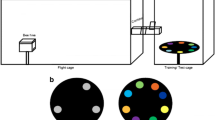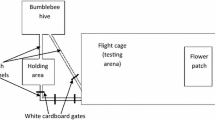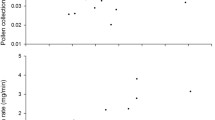Abstract
Studies of innate colour preference and learning ability have focused on differences at the species level, rather than variation among populations of a single species. Initial strength and persistence of colour preferences are likely to affect colour choices of naïve flower visitors. We therefore study the influence of both the strength and persistence of innate colour preference (for blue) on an operant learning task (associating food reward with yellow flowers) in two populations of the bumblebee Bombus terrestris. We found that both strength and persistence of blue preference differed significantly between populations: B. terrestris dalmatinus had a weaker and less persistent blue preference than B. terrestris audax. These differences in preference also influenced learning performance. Considering only landing behaviours, one-trial learning occurred in the majority (73%) of bees, and was achieved sooner in B. terrestris dalmatinus because of its weaker blue preference. However, compared to landing behaviours the relative frequency of approach flights to rewarding and unrewarding flower types changed more slowly with task experience in both populations. When considering both approaches and landings, the rate of learning, following the first rewarded learning trial, was faster in B. terrestris audax than B. terrestris dalmatinus. However, the net effects of population differences in blue preference and learning dynamics result in similar final levels of task performance. Our results provide new evidence of behavioural differences among isolated populations within a single species, and raise intriguing questions about the ecological significance and adaptive nature of colour preference.




Similar content being viewed by others
References
Banschbach VS (1994) Colour association influences honey bee choice between sucrose concentrations. J Comp Physiol A 175:107–114
Brillet C, Robinson GE, Bues R, Le Conte Y (2002) Racial differences in division of labor in colonies of the honey bee (Apis mellifera). Ethology 108:115–126
Chittka L, Ings TC, Raine NE (2004) Chance and adaptation in the evolution of island bumblebee behaviour. Popul Ecol 46:243–251
Coppée A, Terzo M, Valterova I, Rasmont P (2008) Intraspecific variation of the cephalic labial gland secretions in Bombus terrestris (L.) (Hymenoptera: Apidae). Chem Biodivers 5:2654–2661
de Brito Sanchez G, Chen C, Li JJ, Gauthier M, Giurfa M (2008) Behavioral studies on tarsal gustation in honeybees: sucrose responsiveness and sucrose-mediated olfactory conditioning. J Comp Physiol A 194:861–869
Dukas R, Real LA (1991) Learning foraging tasks by bees: a comparison between social and solitary species. Anim Behav 42:269–276
Dyer FC, Seeley TD (1991) Dance dialects and foraging range in 3 Asian honey bee species. Behav Ecol Sociobiol 28:227–233
Fewell JH, Bertram SM (2002) Evidence for genetic variation in worker task performance by African and European honey bees. Behav Ecol Sociobiol 52:318–325
Giurfa M, Núñez J, Chittka L, Menzel R (1995) Colour preferences of flower-naive honeybees. J Comp Physiol A 177:247–259
Giurfa M, Hammer M, Stach S, Stollhoff N, Müller-Deisig N, Mizyrycki C (1999) Pattern learning by honeybees: conditioning procedure and recognition strategy. Anim Behav 57:315–324
Gonçalves-Souza T, Omena PM, Souza JC, Romero GQ (2008) Trait-mediated effects on flowers: artificial spiders deceive pollinators and decrease plant fitness. Ecology 89:2407–2413
Gumbert A (2000) Color choices by bumble bees (Bombus terrestris): innate preferences and generalization after learning. Behav Ecol Sociobiol 48:36–43
Heinrich B (1979) Bumblebee Economics. Harvard University Press, Cambridge
Heinrich B, Mudge PR, Deringis PG (1977) Laboratory analysis of flower constancy in foraging bumble bees: Bombus ternarius and B. terricola. Behav Ecol Sociobiol 2:247–265
Hurlbert A, Ling Y (2007) Biological components of sex differences in color preference. Curr Biol 17:R623–625
Ings TC, Chittka L (2008) Speed–accuracy tradeoffs and false alarms in bee responses to cryptic predators. Curr Biol 18:1520–1524
Ings TC, Raine NE, Chittka L (2005) Mating preference in the commercially imported bumblebee species Bombus terrestris in Britain (Hymenoptera: Apidae). Entomol Gen 28:233–238
Ings TC, Ward NL, Chittka L (2006) Can commercially imported bumble bees out-compete their native conspecifics? J Appl Ecol 43:940–948
Kamel SM, Strange JP, Sheppard WS (2003) A scientific note on hygienic behavior in Apis mellifera lamarckii and A. m. carnica in Egypt. Apidologie 34:189–190
Kelber A (1996) Colour learning in the hawkmoth Macroglossum stellatarum. J Exp Biol 199:1127–1131
Lauer J, Lindauer M (1973) Die Beteiligung von Lernprozessen bei der Orientierung. Forts Zool 21:349–370
Lunau K, Maier EJ (1995) Innate color preferences of flower visitors. J Comp Physiol A 177:1–19
Lunau K, Wacht S, Chittka L (1996) Colour choices of naive bumble bees and their implications for colour perception. J Comp Physiol A 178:477–489
Marshall J (1935) On the sensitivity of the chemoreceptors on the antenna and fore-tarsus of the honey-bee, Apis mellifica L. J Exp Biol 12:17–26
Menzel R (1967) Untersuchungen zum Erlernen von Spektralfarben durch die Honigbiene (Apis mellifica). Z Vergl Physiol 56:22–62
Menzel R (1985) Learning in honey bees in an ecological and behavioral context. In: Hölldobler B, Lindauer M (eds) Experimental Behavioral Ecology. Gustav Fischer Verlag, Stuttgart, pp 55–74
Menzel R, Freudel H, Rühl U (1973) Intraspecific differences in the learning behaviour of the honey bee (Apis mellifera L.). Apidologie 4:1–24
Molet M, Chittka L, Raine NE (2009) How floral odours are learned inside the bumblebee (Bombus terrestris) nest. Naturwissenschaften 96:213–219
Ollerton J, Lack AJ (1992) Flowering phenology: an example of relaxation of natural selection? Trends Ecol Evol 7:274–276
Pohl F, Watolla T, Lunau K (2008) Anther-mimicking floral guides exploit a conflict between innate preference and learning in bumblebees (Bombus terrestris). Behav Ecol Sociobiol 63:295–302
Raine NE, Chittka L (2005) Comparison of flower constancy and foraging performance in three bumblebee species (Hymenoptera: Apidae: Bombus). Entomol Gen 28:81–89
Raine NE, Chittka L (2007) The adaptive significance of sensory bias in a foraging context: floral colour preferences in the bumblebee Bombus terrestris. PLoS One 2:e556. doi:10.1371/journal.pone.0000556
Raine NE, Chittka L (2008) The correlation of learning speed and natural foraging success in bumble-bees. Proc Roy Soc B 275:803–808
Raine NE, Ings TC, Dornhaus A, Saleh N, Chittka L (2006a) Adaptation, genetic drift, pleiotropy, and history in the evolution of bee foraging behavior. Adv Stud Behav 36:305–354
Raine NE, Ings TC, Ramos-Rodríguez O, Chittka L (2006b) Intercolony variation in learning performance of a wild British bumblebee population (Hymenoptera: Apidae: Bombus terrestris audax). Entomol Gen 28:241–256
Rasmont P, Coppée A, Michez D, de Meulemeester T (2008) An overview of the Bombus terrestris (L. 1758) subspecies (Hymenoptera: Apidae). Ann Soc Entomol Fr 44:243–250
Rescorla RA, Wagner AR (1972) A theory of classical conditioning: variations in the effectiveness of reinforcement and non-reinforcement. In: Black AH, Prokasy WF (eds) Classical conditioning II: current research and theory. Appleton-Century-Crofts, New York, pp 64–99
Skorupski P, Döring TF, Chittka L (2007) Photoreceptor spectral sensitivity in island and mainland populations of the bumblebee, Bombus terrestris. J Comp Physiol A 193:485–494
Smithson A, Macnair MR (1996) Frequency-dependent selection by pollinators: mechanisms and consequences with regard to behaviour of bumblebees Bombus terrestris (L) (Hymenoptera: Apidae). J Evol Biol 9:571–588
Spaethe J, Tautz J, Chittka L (2001) Visual constraints in foraging bumblebees: flower size and color affect search time and flight behavior. Proc Natl Acad Sci 98:3898–3903
Spence R, Smith C (2008) Innate and learned colour preference in the zebrafish, Danio rerio. Ethology 114:582–588
Srinivasan MV, Lehrer M (1984) Temporal acuity of honeybee vision: behavioural studies using moving stimuli. J Comp Physiol A 155:297–312
Velthuis HHW, van Doorn A (2006) A century of advances in bumblebee domestication and the economic and environmental aspects of its commercialization for pollination. Apidologie 37:421–451
Weiss MR (1997) Innate colour preferences and flexible colour learning in the pipevine swallowtail. Anim Behav 53:1043–1052
Willmer PG, Stone GN (2004) Behavioral, ecological, and physiological determinants of the activity patterns of bees. Adv Stud Behav 34:347–466
Yokoi T, Fujisaki K (2009) Hesitation behaviour of hoverflies Sphaerophoria spp. to avoid ambush by crab spiders. Naturwissenschaften 96:195–200
Acknowledgements
We would like to thank Oscar Ramos Rodríguez for his assistance with colony rearing, maintenance and testing bees and Zainab Afzal, Chris Armstrong, Denise Barrow, Samiya Batul, Rosa Hardt, Amanda Hill, Sibel Ihsan, Anna Lo, Natalia Lopez, Nicole Milligan, Rohini Simbodyal, Ralph Stelzer, Matthew Wallace and Tulay Yilmaz for their help with the experiments. This study was supported by a Queen Mary College Scholarship and University of London Central Research Fund grant (CRFT1C7R) awarded to TCI and an NERC grant (NER/A/S/2003/00469) awarded to LC and NER. The experiments comply with the current laws of the country in which they were performed.
Author information
Authors and Affiliations
Corresponding author
Additional information
Communicated by M. Giurfa
Rights and permissions
About this article
Cite this article
Ings, T.C., Raine, N.E. & Chittka, L. A population comparison of the strength and persistence of innate colour preference and learning speed in the bumblebee Bombus terrestris . Behav Ecol Sociobiol 63, 1207–1218 (2009). https://doi.org/10.1007/s00265-009-0731-8
Received:
Revised:
Accepted:
Published:
Issue Date:
DOI: https://doi.org/10.1007/s00265-009-0731-8




